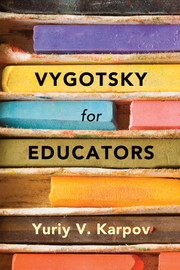Book contents
- Frontmatter
- Dedication
- Contents
- List of Figures
- Acknowledgments
- Introduction
- Part I Mediation from Birth through Adolescence
- Part II School: What to Teach and How to Teach
- 8 American Cognitive Psychologists and Russian Vygotskians talk about the Content and Process of Learning at School
- 9 What Do Students Learn in “Traditional” Schools?
- 10 Does Constructivist Instruction Present a Good Alternative to “Traditional” Teaching?
- 11 The Vygotskian Theoretical Learning Approach as an Alternative to “Traditional” Explicit Instruction and to Constructivist Instruction
- Conclusion
- Notes
- Index
11 - The Vygotskian Theoretical Learning Approach as an Alternative to “Traditional” Explicit Instruction and to Constructivist Instruction
Published online by Cambridge University Press: 05 June 2014
- Frontmatter
- Dedication
- Contents
- List of Figures
- Acknowledgments
- Introduction
- Part I Mediation from Birth through Adolescence
- Part II School: What to Teach and How to Teach
- 8 American Cognitive Psychologists and Russian Vygotskians talk about the Content and Process of Learning at School
- 9 What Do Students Learn in “Traditional” Schools?
- 10 Does Constructivist Instruction Present a Good Alternative to “Traditional” Teaching?
- 11 The Vygotskian Theoretical Learning Approach as an Alternative to “Traditional” Explicit Instruction and to Constructivist Instruction
- Conclusion
- Notes
- Index
Summary
The Theoretical Learning Approach: An Overview
The theoretical learning approach to instruction has been developed by Russian Vygotskians on the basis of Vygotsky’s notions of scientific knowledge as psychological tools, and teaching these tools as the major content of mediation at school. Proceeding from these notions, teaching scientific knowledge should be organized just as any other type of mediation: the teacher presents ready-made scientific knowledge to students in the external form; students appropriate this knowledge and then use and increasingly master it under the teacher’s supervision; as a result, this knowledge becomes internalized and turns into an internal mediator of students’ thinking and problem solving.
What is the scientific knowledge that we should explicitly teach to students? As discussed in Chapter 8, the answer to this question was suggested by the Vygotskians back in the 1930s (half a century before American cognitive psychologists came up with the same idea): Scientific knowledge taught to students should be a combination of subject-domain procedural and conceptual knowledge. Such “marrying concepts to procedures” makes the procedural knowledge meaningful and transferable; therefore, students become able to use this knowledge in novel situations to solve relevant subject domain problems.
- Type
- Chapter
- Information
- Vygotsky for Educators , pp. 185 - 203Publisher: Cambridge University PressPrint publication year: 2014



